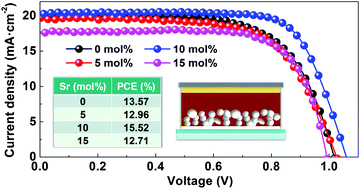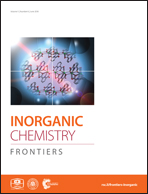The effect of SrI2 substitution on perovskite film formation and its photovoltaic properties via two different deposition methods†
Abstract
The poisonous metal lead (Pb) is one of the key limiting factors for the large-scale industrial application of perovskite solar cells (PSCs). Here, we replaced some of the lead iodide (PbI2) with strontium iodide (SrI2) in the precursor solution to prepare Pb-less perovskite films and fabricate mesoscopic solar cells via the antisolvent-assisted single step method and the two-step spin-coating method. The effect of Sr substitution on the film formation and photovoltaic properties of perovskites was illuminated by scanning electron microscopy (SEM), X-ray diffraction (XRD) and time-resolved photoluminescence (TRPL) analyses. The results show that, in the antisolvent-assisted single step method, Sr substitution has an impact on the formation of the intermediate phase, resulting in a lower coverage and an increased defect density of perovskite films. When the Sr content rises from 0 to 5 mol%, the device's power conversion efficiency (PCE) decreases from 15.22% to 6.37%. In the two-step spin-coating method, a moderate amount of SrI2 can change the chemical composition of the PbI2 precursor, resulting in less PbI2 and a decreased defect density in perovskite films. When the Sr content is 10 mol% in the PbI2 solution, the solar cell exhibits a considerable PCE of 15.52% under AM 1.5G solar illumination.



 Please wait while we load your content...
Please wait while we load your content...